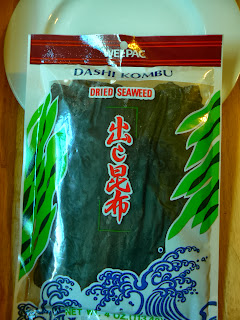I really, really love Japanese food. It's my favorite, and a lot of the philosophy behind washoku (Japanese home cooking) has influenced my cooking and eating style greatly. I'm big on simplicity of ingredients, seasonal cooking, using meat sparingly, and
umami over sweet, all of which can be largely attributed to my deep love for washoku. Dashi is one of the cornerstones of Japanese cooking, and with it's simplicity and versatility, you can definitely see why. You can use dashi anywhere you would use stock, and it's a great, healthy alternative to chicken or beef broth. There are many different kinds of traditional dashi, made from dried shiitake mushrooms, seaweed, etc, but this recipe is the most basic. All you need is kombu (a dried kelp) and bonito (or katsuobushi), which is flakes of dried, smoked skipjack tuna. Any Asian market will have these ingredients, and you should buy a big bag, because once you make dashi, you're gonna end up using it in everything. Also, from a cat lady standpoint, dried bonito flakes make a great cat treat.
What you need:
One big piece of kombu, about 1 oz
2 handfuls bonito flakes (this is a for-real measurement, I swear)
7 cups water
makes 7 cups dashi, which keeps in the fridge for 3-5 days, up to a couple weeks frozen
The kombu is going to have some white powder on it. DO NOT WASH THIS OFF. These are natural salts. Combined with the high amount of glutamic acids, this is what gives dashi its unique flavor, full of umami. I definitely go searching for the powderiest kombu when I'm using it.
Cut your kombu into pieces that fit in whatever pan you're using:
Add the water to your pan and heat it until just before it simmers. It's very important to not let the water boil at all while the kombu is in there, or else your dashi will turn out bitter and slimy.
This is just about right, when teeny bubbles form on the edges of the pan. Turn off the heat and take your kombu out (they can just be thrown away). Then add the bonito flakes:
This is about a handful. The bonito gives the dashi a fishy, smoky flavor. The kombu adds umami, and a sort of sea flavor. You can use more or less of either ingredient to your taste, but please make it one time using these measurements. I know it looks like a lot of bonito, and the intense fishy aroma might give you pause, but it gives the dashi a subtle and complex flavor that isn't overly fishy, I promise. Cover the pan and let the bonito steep for ten minutes. When the ten minutes are up, strain your stock into a bowl using a fine mesh strainer. There will be a teeny bit of bonito dust floating around in your stock. I don't mind it, but if you're going for a perfectly clear dashi, or that sort of thing squicks you out, you can put cheesecloth in the strainer to catch it.
Toss the soggy bonito bits. If you shake the strainer a bit from side to side, the wet bonito will clump together in a ball, and make it easier to dump in the trash.
Now you have dashi! Add a bit of miso paste to make a great authentic miso soup, or use it as the base for any hotpot or soup you like.









So, now I'm wondering what this would be like as a base for a new england fish chowder.
ReplyDelete... with kale.
... damnit Beth, I'm going to spend my entire day off cooking.
MUAHHAHAHAHAA. That sounds delicious! Lemm know how it turns out!
Delete